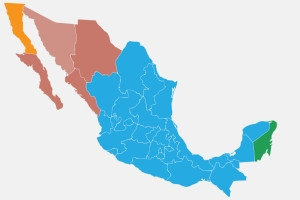Mexico, a country celebrated for its rich culture and diverse landscapes, spans a considerable geographical area. Extending from the Pacific coast to near Florida in longitudinal terms, this vastness means Mexico operates across multiple time zones. Understanding these time zones is key for anyone planning a trip, connecting with people in Mexico, or simply learning more about this fascinating country.
Mexico is divided into four primary time zones, ensuring that different regions of the nation align their clocks appropriately with the sun’s position. These zones are essential for coordinating daily life, business, and travel across this expansive nation. Below is a breakdown of Mexico’s time zones, offering clarity on how time is managed throughout the country.
 Clock Time Watches – Understanding time zones in Mexico
Clock Time Watches – Understanding time zones in Mexico
Here are the four official time zones you’ll find in Mexico, each designated by a specific name and color code for easy identification:
- Zona Noroeste (Northeast Zone) – Orange:
- Zona Pacifico (Pacific Zone) – Burgundy:
- Zona Centro (Central Zone) – Blue:
- Zona Sureste (Southeastern Zone) – Green:
To visualize these zones geographically, refer to the map below which illustrates how Mexico is segmented by time zone.
 Mexico Time Zones Map – Map of Mexico showing different time zones
Mexico Time Zones Map – Map of Mexico showing different time zones
To pinpoint which Mexican states fall into each time zone, the following table provides a detailed guide:
| Time Zone | Mexican States |
|---|---|
| Northwest Time Zone (Zona Noroeste) | Baja California |
| Pacific Time Zone (Zona Pacifico) | Baja California Sur, Chihuahua*, Nayarit, Sinaloa, Sonora** |
| Central Time Zone (Zona Centro) | Aguascalientes, Campeche, Chihuahua*, Chiapas, Coahuila de Zaragoza, Colima, Durango, Guanajuato, Guerrero, Hidalgo, Jalisco, Mexico City, Mexico State, Michoacán, Morelos, Nuevo León, Oaxaca, Puebla, Querétaro, San Luis Potosí, Tabasco, Tamaulipas, Tlaxcala, Veracruz, Yucatán, Zacatecas |
| Southeast Time Zone (Zona Sureste) | Quintana Roo |
*It’s important to note that while the State of Chihuahua officially belongs to the Pacific Time Zone, it commonly aligns its clocks with Mexico’s Central Time Zone for practical purposes.
**The State of Sonora maintains a unique timekeeping practice by permanently synchronizing with the time in Arizona, USA, which does not observe daylight saving time.
In conclusion, Mexico’s time zones are an essential aspect of its geography and daily life. From the Northwest to the Southeast, understanding these time divisions is crucial for navigating time across the country. Whether you’re planning a call, scheduling a meeting, or simply curious about the local time, knowing Mexico’s time zones will enhance your understanding of this diverse nation.
